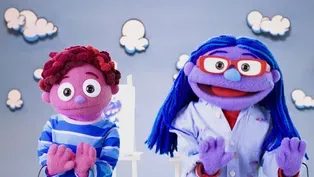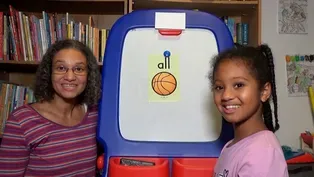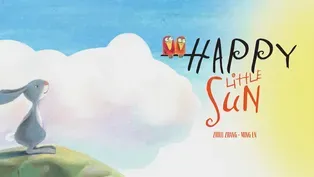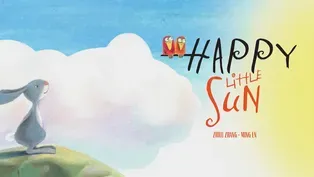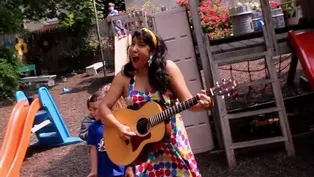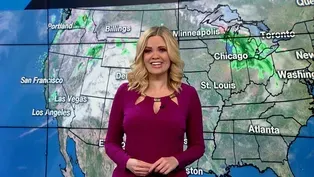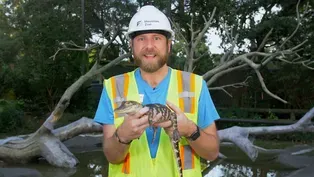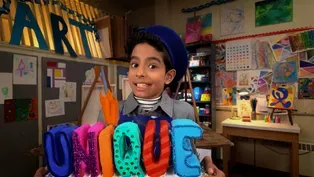
FOLLOW THE RAINBOW
Clip: 7/10/2024 | 8m 28sVideo has Audio Description, Closed Captions
Make a rainbow and a lava lamp with Krystal Balmes from the Brooklyn Preschool of Science.
Krystal Balmes and Sahil from the Brooklyn Preschool of Science make a rainbow with a CD, as well as a lava lamp using water, oil, food coloring, and sodium bicarbonate.
See all videos with Audio DescriptionADProblems with Closed Captions? Closed Captioning Feedback
Problems with Closed Captions? Closed Captioning Feedback
Let's Learn is a local public television program presented by THIRTEEN PBS

FOLLOW THE RAINBOW
Clip: 7/10/2024 | 8m 28sVideo has Audio Description, Closed Captions
Krystal Balmes and Sahil from the Brooklyn Preschool of Science make a rainbow with a CD, as well as a lava lamp using water, oil, food coloring, and sodium bicarbonate.
See all videos with Audio DescriptionADProblems with Closed Captions? Closed Captioning Feedback
How to Watch Let's Learn
Let's Learn is available to stream on pbs.org and the free PBS App, available on iPhone, Apple TV, Android TV, Android smartphones, Amazon Fire TV, Amazon Fire Tablet, Roku, Samsung Smart TV, and Vizio.
Providing Support for PBS.org
Learn Moreabout PBS online sponsorship[cheerful music] - Hi everyone!
My name is Krystal and I'm here at the Brooklyn Preschool of Science.
I'm with my friend, Sahile.
Sahile, can you please say hello?
- Hello.
- How are you today?
- Great.
- Awesome!
Good, I'm glad that you're great.
Okay, so we are going to do some really cool science experiments.
However, before we start with the activities, I would like to talk about light.
Sahile, do you know that white light- - Yeah?
- It's a combination of all the colors in the rainbow.
Have you ever seen a rainbow before?
- [Sahile] Yeah.
- [Krystal] Yes.
Rainbows are multi-colored arcs that form when sunlight travels through water.
As light waves pass through water, that process is called light bending.
Can you say that, Sahile?
Can you say "Light bending?"
- Light bending.
- So we can see rainbows in the mist, fog, during the rain, or even after the rain.
- Yeah.
- Sahile, I'm gonna show you how we can make a rainbow in the classroom.
- In?
- Yeah, right in here.
And friends watching, you can even do this at home, okay?
So first, let's take a moment and let's look at our materials.
So, we actually don't need much for this activity.
All we need are, do you know what these are?
- Yeah.
- What are they called?
- They're like a circle.
- Yeah, there's the shape, good job.
So these are CDs.
- CDs.
- Yeah.
So you need a CD.
How about this, what is this?
- A flashlight.
- Flashlight, good job.
Okay, and then you'll also need to do this in the dark.
So there's your flashlight, I have my flashlight.
And here is a CD for you, and there's a CD for me.
Okay, so now what we are going to do, is we're gonna take the flashlight, okay?
[flashing clicking on] Can you turn it on?
[flashing clicking on] Good job.
And with your other hand, can you pick up your CD, please?
Yes.
What do you see with the CD?
What do you see?
- Rainbow!
- You can see a rainbow already?
- Yeah!
- Yeah, what colors do you see?
- Green, purple and red.
- Yeah, good job.
Do you see any other colors?
- Blue.
- Okay, good job.
So the colors of the rainbow are red, orange, yellow, green, blue, indigo, red.
When we count to three the lights are off, I want you to take your flashlight, point it to the CD just like this.
It's got a flash on it.
And then maybe, let's try to point it towards the wall.
Okay?
Can you aim for the wall, Sahile?
- [Both] Three, two, one!
Lights off.
Oo, oo, oo.
- Oo.
- It's dark.
Okay Sahile, so now let's practice making our rainbows.
Let's see, I'm gonna try to make a rainbow on the wall behind us.
Let's see if I can do that.
I have my CD, going to face it towards the wall.
Okay, I'm gonna point my flashlight onto the CD just like that, I'm gonna flash it on, and let's see.
Hey Sahile, do me a favor.
Look at the wall and tell me if you can see any colors.
- I can't see some.
- You can or no?
- No.
- All right, let me know when you can, okay?
You let me know.
[thoughtful music] - Now I can see some.
- Yes?
Can you shout out the colors you see?
- Yeah.
- What colors do you see.
- All of them.
- Do you see red?
- Yeah.
- Yellow?
- Yeah.
- Green?
- Yeah.
- Yes, whoa!
Blue?
- Yeah.
- Whoa, good job.
Let me keep trying.
[thoughtful music] Let's see.
Whoa!
Bending the light.
Light bending.
Hey Sahile, can you try to make a rainbow, oh, oh, hey!
Look at the white right there on the tank.
What colors do you see?
I see red, I see orange, I see yellow, I see green, I see blue.
Can you see the colors?
- Yeah.
- And this is awesome, because you can do this at home, friends.
For our next activity, okay, let's take a moment and look at this here.
Do you know what this is called?
- Yeah.
- What is it called?
- A rainbow inside.
- Oh yeah, we do see, there are many colors in there, yes, just like a rainbow.
But this is called a lava lamp.
- Lava lamp.
- Yes, it's a lava lamp, okay.
So now look at the inside.
What do you see inside lava lamps, Sahile?
What is that?
- [Sahile] Rainbows.
- Okay, you see the colors.
And what is that inside?
Is that liquid?
- No.
- Yes, that is.
That's liquid inside.
You see, there's some water, and there's some wax.
You see wax?
- Wax!
- The wax.
Now you see this lamp is plugged in.
- Plugged in.
- Yeah, so it's nice and warm.
So now, when this heats up the wax inside, it moves up and down, and it makes these really different shapes.
- Does it go up and down?
- Yeah, up and down.
And I'm gonna show you all the materials that we need to make our lava lamp at home, okay?
So we have some food coloring.
I have four cups of water, two cups of oil.
And I have some sodium bicarbonate.
And I have a container here, a nice glass container.
But you can use any empty container at home.
Make sure that is clear, because you wanna see what's happening inside.
So Sahile, I'm going to need your help, okay?
- Okay.
- Can you please, I'm gonna take, we're gonna pour these liquids in here.
First, we're gonna pour the four cups of water.
Please take the water and carefully pour it into, right in there, in the container.
[water pouring] Thank you, sir.
Okay, now we're gonna pour the other cups of water, too.
I'll help you.
You can pour that cup now.
[playful music] Good job.
Okay, so now we've poured in our water, Sahile.
We're just gonna pour, I'm gonna put a few drops of this food coloring in here.
How many should I put like two, four or six drops?
How many?
- Six.
- Six, okay.
Can you count with me?
- Yeah.
- [Both] One, two, three, four, five, six.
- Good job, okay.
- Now it's red!
- Yes, that's right, right?
So we did four cups of water, right?
We added six drops of food coloring, and now we're gonna pour two cups of oil.
- Oil.
- Yes.
Okay, be very careful with the oil.
And at home, friends, please do this experiment with a trusted adult, okay.
So good job, Sahile.
[playful music] There goes, one.
Oo, oo, oo!
- It's getting to the top!
- That's right.
One more.
[playful music] You're doing a great job.
Thank you.
[playful music] Taking your time, perfect.
Good job, buddy.
Okay, so I'm gonna take this here.
So now, I have some sodium bicarbonate here, okay?
These tablets.
So, Sahile, when I tell you to, okay?
We're going to take this tablet, and I would like you to please drop it into this container.
And I want you to watch and see what happens, okay?
- Okay.
- And then, can you tell me what's happening?
Tell me what you see.
Okay, ready sir?
- Yeah.
- There you go, you take one, and I'm gonna take one, too.
We're gonna drop it together at the same time.
- Yeah.
- Ready?
One- - Two- - Two- - Three- - Three.
Opp, let's see what happens.
Whoa, wait a minute, look!
- What happened?
- Whoa, look what's happening!
- Yeah!
- What do you see coming to the top?
They're round, what are they?
- Um...colors.
- Yeah, I see colors.
Do you see bubbles?
- Yeah.
- Do you see the bubbles?
- Yeah.
- Wow, this is amazing.
We just made our own lava lamp.
- Can you say, "Science rocks!"
- Science rocks.
- Awesome.
Can we say bye to our friends at home?
- Bye.
- Bye friends, see you soon!
FEEL YOUR BEST SELF: PUSH THE CLOUDS
Video has Audio Description, Closed Captions
Learn how to push away dark clouds of unhappy thoughts to make way for sunnier thoughts. (6m 7s)
Video has Audio Description, Closed Captions
Explore the glued/welded sound "all" with Anna Scretching-Cole and her two daughters. (7m 25s)
Video has Audio Description, Closed Captions
Anna Scretching-Cole reads HAPPY LITTLE SUN by Zhilu Zhang and illustrated by Ming En. (6m 3s)
Video has Audio Description, Closed Captions
Anna Scretching-Cole reads HAPPY LITTLE SUN by Zhilu Zhang and illustrated by Ming En. (6m 3s)
Video has Audio Description, Closed Captions
Sing “A Jugar” in Spanish with Flor Bromley! (2m 7s)
MATH AND MOVEMENT: POSITIONAL LANGUAGE
Video has Audio Description, Closed Captions
Caitlin Cargill and Madison play a math movement game to explore positional language. (5m 43s)
MEET THE HELPERS: METEOROLOGIST
Video has Audio Description, Closed Captions
Meet a meteorologist, who predicts if sunny weather is headed our way. (43s)
Video has Audio Description, Closed Captions
Learn how alligators like Brutus at the Houston Zoo use the sun to stay warm. (1m 31s)
Video has Audio Description, Closed Captions
Renata Townsend from New Victory shows how to tell a story with shadow puppets. (3m 48s)
WORDSVILLE: THE CASE OF THE UNIQUE TWEAK
Video has Audio Description, Closed Captions
Artist Clay discovers his "unique" sculpture is missing. Word Detectives are on the case! (7m 27s)
Video has Audio Description, Closed Captions
Learn some Taekwondo moves with Zachary! (1m 1s)
Providing Support for PBS.org
Learn Moreabout PBS online sponsorshipSupport for PBS provided by:
Let's Learn is a local public television program presented by THIRTEEN PBS
